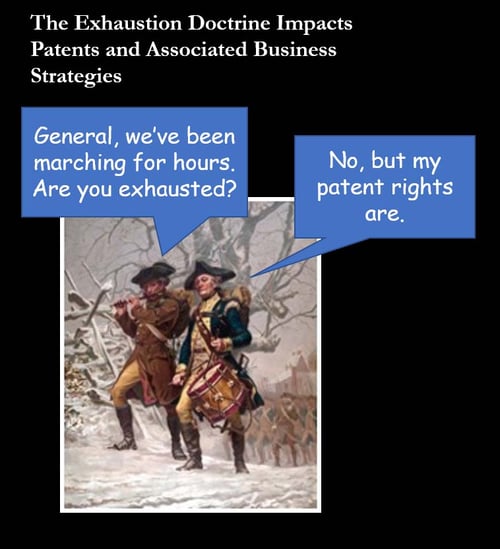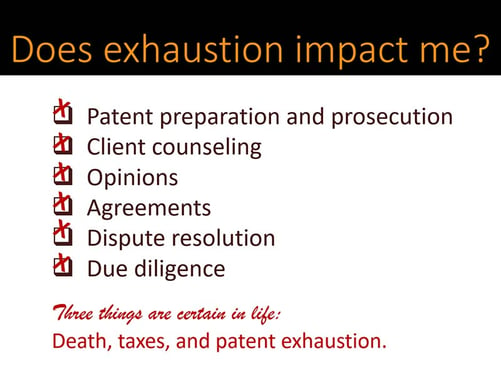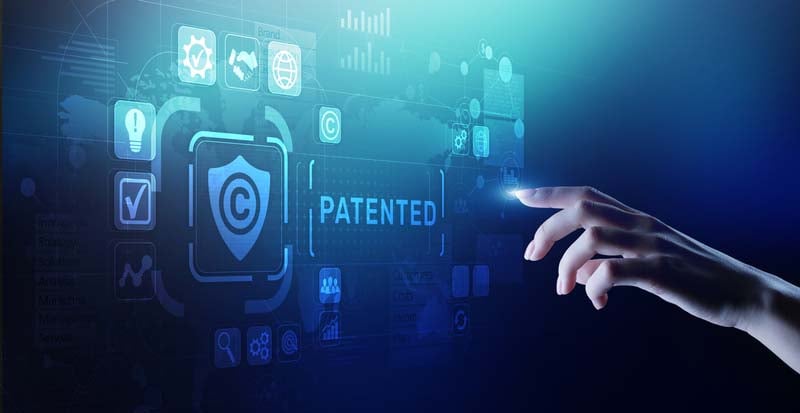U.S. patent law authorizes an inventor to secure patent protection for inventive machines, articles of manufacture, methods, and compositions that are useful. 35 USC 101. Patent protection allows the patentee to exclude others from making, using, selling, offering to sell, or importing a patented invention. This is a powerful catalog of rights. A party that makes, uses, sells, offers to sell, or imports a patented invention without authorization of the patentee directly infringes the patent. 35 USC 271(a). A party can also indirectly infringe a patent by inducing or contributing to the infringement of a direct infringer. 35 USC 271 (b) and (c).
 The exhaustion doctrine, a creation of the case law and not of statute at present, cuts off the patentee’s otherwise powerful right to exclude. Upon the first, authorized sale of a patented item, the patentee thereafter has no ability to use patent rights to control using, selling, offering to sell, and importing the sold item. The law has evolved so that even selling an unpatented item (such as a precursor or merely component(s) of a patented combination) can trigger exhaustion of patent rights.
The exhaustion doctrine, a creation of the case law and not of statute at present, cuts off the patentee’s otherwise powerful right to exclude. Upon the first, authorized sale of a patented item, the patentee thereafter has no ability to use patent rights to control using, selling, offering to sell, and importing the sold item. The law has evolved so that even selling an unpatented item (such as a precursor or merely component(s) of a patented combination) can trigger exhaustion of patent rights.
Traditionally, exhaustion limited only the using, selling, offering to sell, or importing portions of the exclusion rights after a first authorized sale occurred. The right to exclude others from making would not be exhausted. This seems logical since exhaustion applies to the particular item sold, not to other items. However, the making right is no longer insulated from exhaustion. The Supreme Court in its Quanta decision (discussed below) made clear that method claims can be exhausted by sale of critical components used in method. Further, the law also has evolved so that exhaustion very likely impacts the ability of patentee to exclude others from making the patented invention based on sale of an unpatented machine whose only function is to make patented items.
Due to the exhaustion doctrine, patent rights are most useful to protect inventions up to the point that an invention is first sold by or under the authority of patentee. Patent rights are much less useful to protect the item after the first sale. This means patents are best at protecting new items and less useful to protect used items.
The exhaustion of patent rights is a significant loss, but patent exhaustion does not leave patentee defenseless. Exhaustion only applies to items sold, not to other items. Hence, each patented item generally is entitled to its own individual exhaustion trigger, although case law developments do allow exhaustion of one item to infect others in some circumstances. Further, even though enforcement of patent rights might be off the table due to exhaustion, the patentee may have other legal claims to enforce, such as those occurring under contract, unfair competition, trade secret, inducing breach of contract, and the like.
 Simple exhaustion situations tend not to be litigated. It is easy to understand that there is a legitimate market for selling and buying used items. But, not all exhaustion triggers or consequences are simple to perceive. Hence, the case law tends to be filled with complex scenarios where evaluating if and to what extent exhaustion occurred is quite challenging. When does an authorized sale first occur? Are sales restrictions effective to stop exhaustion? Are field restrictions in a license effective to protect patentee from exhaustion being triggered to soon? Does a license grant itself trigger exhaustion? What exhaustion risks result when patentee sets up authorized sources of materials or equipment to help its customers or licensees? Can international activity trigger exhaustion in the U.S.? Why is precedent disregarded or manipulated so often in judicial analysis as the doctrine evolves?
Simple exhaustion situations tend not to be litigated. It is easy to understand that there is a legitimate market for selling and buying used items. But, not all exhaustion triggers or consequences are simple to perceive. Hence, the case law tends to be filled with complex scenarios where evaluating if and to what extent exhaustion occurred is quite challenging. When does an authorized sale first occur? Are sales restrictions effective to stop exhaustion? Are field restrictions in a license effective to protect patentee from exhaustion being triggered to soon? Does a license grant itself trigger exhaustion? What exhaustion risks result when patentee sets up authorized sources of materials or equipment to help its customers or licensees? Can international activity trigger exhaustion in the U.S.? Why is precedent disregarded or manipulated so often in judicial analysis as the doctrine evolves?
The answers to these questions are surprising with the consequence that the exhaustion doctrine limits patent rights and associated business strategies in ways that are counterintuitive. The doctrine can surprisingly nullify business models that otherwise seem to be based on common sense.
For example, in a recent Supreme Court case (the Impression case discussed below), the technology innovator/patent owner used what seemed like a sensible strategy to protect itself from the refurbishing market while at the same time providing purchase options to treat its customers fairly. But the Supreme Court painted the patent owner as a villain, while the technology pirate was drawn as the hero. To accomplish this role swap, the Supreme Court expanded the exhaustion doctrine in two important respects, making the doctrine a more potent defense and weakening patents in the process.
The expansion that occurred in the Impression case is part of an overall trend that continues to create more and more exhaustion triggers. Increasingly, the doctrine treats patent owners poorly, accused infringers can defend a wider range of conduct, and yesterday’s case might not apply tomorrow due to judicial creativity in applying precedent.

